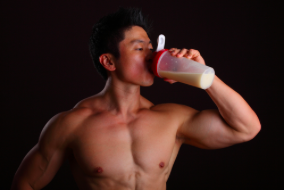[fusion_builder_container hundred_percent=”no” equal_height_columns=”no” hide_on_mobile=”small-visibility,medium-visibility,large-visibility” background_position=”center center” background_repeat=”no-repeat” fade=”no” background_parallax=”none” parallax_speed=”0.3″ video_aspect_ratio=”16:9″ video_loop=”yes” video_mute=”yes” border_style=”solid”][fusion_builder_row][fusion_builder_column type=”1_1″ layout=”1_1″ background_position=”left top” background_color=”” border_size=”” border_color=”” border_style=”solid” border_position=”all” spacing=”yes” background_image=”” background_repeat=”no-repeat” padding=”” margin_top=”0px” margin_bottom=”0px” class=”” id=”” animation_type=”” animation_speed=”0.3″ animation_direction=”left” hide_on_mobile=”small-visibility,medium-visibility,large-visibility” center_content=”no” last=”no” min_height=”” hover_type=”none” link=””][fusion_text]
by David Robson
Of the three macronutrients responsible for supporting health, wellbeing and the muscle building process, protein could be classed as the nutritional rock star. In fact, an exhortation to consume large quantities of it forms the most commonly expressed, though outrageously simplistic, of bodybuilding mandates: lift heavy and eat more protein! Protein is the major building nutrient for all of the cells of our body and fundamentally important for the proper functioning of our many biological processes. In short, proteins build new tissues, repair those that have been damaged and allow our biological machinery to function as nature intended.
As fundamental components of all living things, proteins comprise of substances such as hormones, antibodies and enzymes. The hardest working of molecules, proteins put in a great deal of overtime to ensure that the multiple chemical processes of varying complexity that take place within our 100 trillion cells are simultaneously engaged. Certain proteins fit, lock and key style, into cell receptors to stop or start various functions, while others are suppliers, shuttling a multitude of molecules around the body. For example, hemoglobin, an oxygen-binding protein, carries oxygen to tissues to support their continued survival.
 Whether we wish merely to survive, or have committed ourselves to pursuing bodybuilding excellence and must therefore recover properly between workouts to build more muscle tissue, all humans require sufficient dietary protein. An optimal complement of protein necessary for supporting our activity levels, body type, and training goals is a mandatory, non-negotiable means to boosting performance and establishing the muscle gains we seek to stimulate via arduous training sessions. Protein also doubles as a fuel source: at four calories per gram, it mirrors carbohydrate in its energy content; it is not, however, the body’s preferred energy supplier. That role belongs to carbohydrates.
Whether we wish merely to survive, or have committed ourselves to pursuing bodybuilding excellence and must therefore recover properly between workouts to build more muscle tissue, all humans require sufficient dietary protein. An optimal complement of protein necessary for supporting our activity levels, body type, and training goals is a mandatory, non-negotiable means to boosting performance and establishing the muscle gains we seek to stimulate via arduous training sessions. Protein also doubles as a fuel source: at four calories per gram, it mirrors carbohydrate in its energy content; it is not, however, the body’s preferred energy supplier. That role belongs to carbohydrates.
Getting big, and ripped, with protein
Protein also enables us to achieve a shredded appearance and is essential for optimal weight management. More metabolically advantageous than any other nutrient, protein may produce a 5%-10% increase in our metabolic rate within 8-15 minutes of consuming protein rich foods. Essential for tissue repair, protein builds larger muscles which, being the most metabolically active tissue we have, may, in turn, further elevate the rate at which we burn calories at rest. Furthermore, for every 1000 calories of protein we consume, 300 calories are expended to facilitate its digestion. By ensuring protein comprises of (around) 30 percent plus of our daily caloric intake, we may optimize protein synthesis while preventing the spontaneous consumption of carbohydrates (a leading cause of obesity), and significantly decreasing appetite. Given that muscle growth requires a tremendous amount of energy, the protein so integral to protein synthesis we consume, may prompt a metabolic boost and further fat loss. To ensure we maximize the metabolic effects of protein and consume enough of it to replace and repair damaged muscle, we must aim for a minimum of one-gram-per-pound-of-bodyweight per day, preferably stretched over 5-6 meals, each comprising of between 30-40 grams of high quality proteins rich in essential amino acids. A 200lb lifter would, on this basis, consume between 200 grams+ of protein per day.
Protein composition
Protein is, compositionally speaking, a complex organic macromolecule comprised of carbon, hydrogen, oxygen, nitrogen and sulfur. It contains one or more polymer (or large molecular) chains of amino acids (building blocks of protein) linked together in sequences specific to the actions for which they are responsible. Certain amino sequences represent different proteins (like hemoglobin) and their functions (for example, oxygen transportation). High quality protein sources contain more of the essential amino acids, which the body cannot manufacture on its own. Easier to obtain as they are made by the body from essential amino acids and through protein degradation are the non-essential aminos; like the essential amino acids, the non-essentials have functions specific to their design and must be available for both the proper functioning of our cells and muscle tissue development. The nine essential amino acids are: Histidine, Isoleucine, Leucine, Lysine, Methionine, Phenylalanine, Threonine, Tryptophan and Valine; the 13 non-essential aminos are: Alanine, Cysteine, Cystine, Glutamine, Glutathione, Glycine, Histidine, Serine, Taurine, Threonine, Asparagine, Aspartic acid, Proline. Since they are harder to obtain, is important that all serious bodybuilders strive to consume enough essential aminos through a diet heavy on quality, high biological value protein sources (discussed in part 2).
Check in tomorrow for part 2 when David will delve into which protein sources science tells us are best and why!
Other Macronutrient Article Series:
- Understanding The Macros: Carbs
- Understanding The Macros: Fats (Part 1)
- Understanding The Macros: Fats (Part 2)
[/fusion_text][/fusion_builder_column][fusion_builder_column type=”1_1″ layout=”1_1″ background_position=”left top” background_color=”” border_size=”” border_color=”” border_style=”solid” border_position=”all” spacing=”yes” background_image=”” background_repeat=”no-repeat” padding=”” margin_top=”0px” margin_bottom=”0px” class=”” id=”” animation_type=”” animation_speed=”0.3″ animation_direction=”left” hide_on_mobile=”small-visibility,medium-visibility,large-visibility” center_content=”no” last=”no” min_height=”” hover_type=”none” link=””][fusion_text][/fusion_builder_container
][/fusion_builder_row][/fusion_text][/fusion_builder_column][/fusion_builder_row][/fusion_builder_container][fusion_builder_container hundred_percent=”no” equal_height_columns=”no” menu_anchor=”” hide_on_mobile=”small-visibility,medium-visibility,large-visibility” class=”” id=”” background_color=”” background_image=”” background_position=”center center” background_repeat=”no-repeat” fade=”no” background_parallax=”none” parallax_speed=”0.3″ video_mp4=”” video_webm=”” video_ogv=”” video_url=”” video_aspect_ratio=”16:9″ video_loop=”yes” video_mute=”yes” overlay_color=”” video_preview_image=”” border_size=”” border_color=”” border_style=”solid” padding_top=”” padding_bottom=”” padding_left=”” padding_right=””][/fusion_builder_container]